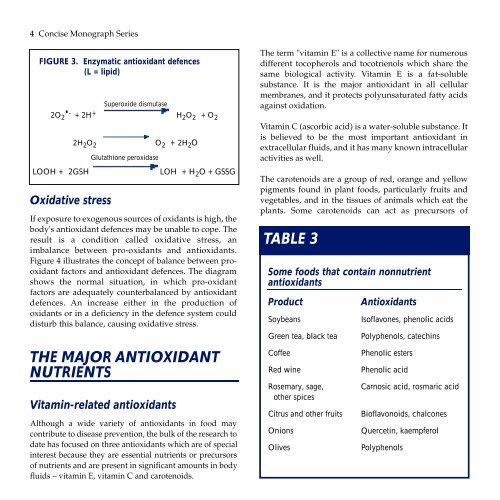Oxidants, Antioxidants and Disease Prevention - Aara-Super food
Oxidants, Antioxidants and Disease Prevention - Aara-Super food
Oxidants, Antioxidants and Disease Prevention - Aara-Super food
You also want an ePaper? Increase the reach of your titles
YUMPU automatically turns print PDFs into web optimized ePapers that Google loves.
4 Concise Monograph Series<br />
FIGURE 3. Enzymatic antioxidant defences<br />
(L = lipid)<br />
2O 2<br />
. - + 2H + H 2 O 2 + O 2<br />
2H 2 O 2<br />
LOOH + 2GSH<br />
Oxidative stress<br />
<strong>Super</strong>oxide dismutase<br />
Glutathione peroxidase<br />
If exposure to exogenous sources of oxidants is high, the<br />
body's antioxidant defences may be unable to cope. The<br />
result is a condition called oxidative stress, an<br />
imbalance between pro-oxidants <strong>and</strong> antioxidants.<br />
Figure 4 illustrates the concept of balance between prooxidant<br />
factors <strong>and</strong> antioxidant defences. The diagram<br />
shows the normal situation, in which pro - o x i d a n t<br />
factors are adequately counterbalanced by antioxidant<br />
defences. An increase either in the production of<br />
oxidants or in a deficiency in the defence system could<br />
disturb this balance, causing oxidative stress.<br />
THE MAJOR ANTIOXIDANT<br />
NUTRIENTS<br />
Vitamin-related antioxidants<br />
O 2 + 2H 2 O<br />
LOH + H 2 O + GSSG<br />
Although a wide variety of antioxidants in <strong>food</strong> may<br />
contribute to disease prevention, the bulk of the research to<br />
date has focused on three antioxidants which are of special<br />
interest because they are essential nutrients or precursors<br />
of nutrients <strong>and</strong> are present in significant amounts in body<br />
fluids – vitamin E, vitamin C <strong>and</strong> carotenoids.<br />
The term "vitamin E" is a collective name for numerous<br />
different tocopherols <strong>and</strong> tocotrienols which share the<br />
same biological activity. Vitamin E is a fat-soluble<br />
substance. It is the major antioxidant in all cellular<br />
membranes, <strong>and</strong> it protects polyunsaturated fatty acids<br />
against oxidation.<br />
Vitamin C (ascorbic acid) is a water-soluble substance. It<br />
is believed to be the most important antioxidant in<br />
extracellular fluids, <strong>and</strong> it has many known intracellular<br />
activities as well.<br />
The carotenoids are a group of red, orange <strong>and</strong> yellow<br />
pigments found in plant <strong>food</strong>s, particularly fruits <strong>and</strong><br />
vegetables, <strong>and</strong> in the tissues of animals which eat the<br />
plants. Some carotenoids can act as precursors of<br />
TABLE 3<br />
Some <strong>food</strong>s that contain nonnutrient<br />
antioxidants<br />
Product<br />
Soybeans<br />
Green tea, black tea<br />
Coffee<br />
Red wine<br />
Rosemary, sage,<br />
other spices<br />
Citrus <strong>and</strong> other fruits<br />
Onions<br />
Olives<br />
<strong>Antioxidants</strong><br />
Isoflavones, phenolic acids<br />
Polyphenols, catechins<br />
Phenolic esters<br />
Phenolic acid<br />
Carnosic acid, rosmaric acid<br />
Bioflavonoids, chalcones<br />
Quercetin, kaempferol<br />
Polyphenols

















